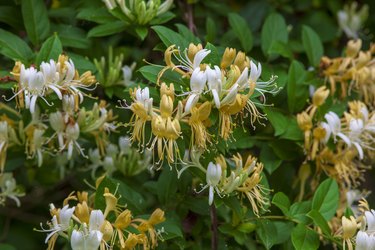
Honeysuckle (Lonicera spp.) is an eye-catching ornamental plant with extremely fragrant flowers. Native varieties grow throughout North America, giving honeysuckle a wide range. It thrives in U.S. Department of Agriculture plant hardiness zones 3 to 11 depending on the species. Like other plants, honeysuckle can get the fungal disease called powdery mildew, but it can be easily controlled if you catch it early.
Meet the Honeysuckle
Video of the Day
Honeysuckle is the general term for the hundred plus species in the Lonicera genus, and what a diverse group they are. Some present as bushes and others as vines, but all produce flowers in white, pink, coral, orange, yellow, or red.
Video of the Day
Honeysuckle can grow virtually anywhere there is sun, and some present a real invasive risk. When selecting honeysuckle varieties for the home garden, avoid Japanese honeysuckle (Lonicera japonica, USDA zones 5b through 8a), which is the worst invasive species. It's important to keep the shrub well pruned to preclude easy escape. Growing honeysuckle in pots can help with the problem as well.
Identify Powdery Mildew
Powdery mildew is a common fungal disease that occurs on a variety of plants, including vegetables, herbs, and ornamental plants. Caused by fungi, powdery mildew appears as white, powdery spots on foliage, generally the upper side of leaves. Left untreated, powdery mildew will spread throughout the plant, robbing it of nutrients.
Powdery mildew affects plants when conditions are warm and dry. That happens when the temperatures rise to 60 to 80 degrees Fahrenheit during the day. It is a myth that powdery mildew requires high humidity. In fact, powdery mildew spores can't germinate or grow when foliage is wet.
The fungi attack the tissues of the honeysuckle, reducing its vigor and blocking sunlight needed for photosynthesis. Infection doesn't kill the plant, but it does cause leaf yellowing and browning, leaf distortion, and premature leaf drop.
Prevent or Treat Powdery Mildew
Monitoring your plants regularly allows you to catch powdery mildew early, and this is the key to keeping it controlled. Once mildew has affected a plant systematically, it is difficult to eradicate. Inspect plants daily for signs of powdery mildew when conditions are appropriate. Start treatment when the first signs of mildew appear.
When caught early, you can treat powdery mildew without toxic chemicals. Neem oil, a natural pesticide derived from the fruits and seeds of the neem tree (Azadirachta indica), is effective. Mix a few tablespoons with a gallon of water in a sprayer and cover the leaves of the plant. Repeat after seven days to eradicate the fungus.
If the infection is too advanced for neem oil treatment, you may need to apply protectant fungicides, such as wettable sulfur, in the earliest stages of disease development. Choose the least toxic product available. Prevent the issue by planting honeysuckle in full sun with adequate space between plants.